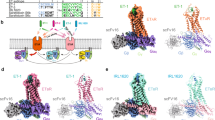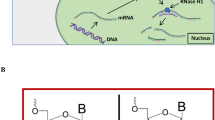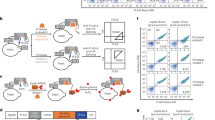Abstract
Amphiphilic peptides approximately fifteen amino acids in length and their corresponding antisense peptides exist within protein molecules. These regions (termed antisense homology boxes) are separated by approximately fifty amino acids. Because many sense–antisense peptide pairs have been reported to recognize and bind to each other, antisense homology boxes may be involved in folding, chaperoning and oligomer formation of proteins. The antisense homology box–derived peptide CALSVDRYRAVASW, a fragment of human endothelin A receptor, proved to be a specific inhibitor of endothelin peptide (ET–1) in a smooth muscle relaxation assay. The peptide was able to block endotoxin–induced shock in rats as well. Our finding of endothelin receptor inhibitor among antisense homology box–derived peptides indicates that searching proteins for this new motif may be useful in finding biologically active peptides.
This is a preview of subscription content, access via your institution
Access options
Subscribe to this journal
Receive 12 print issues and online access
$209.00 per year
only $17.42 per issue
Buy this article
- Purchase on Springer Link
- Instant access to full article PDF
Prices may be subject to local taxes which are calculated during checkout
Similar content being viewed by others
References
Blalock, J.E. & Smith, E.M. Hydropathic anti-complementarity of amino acids based on the genetic code. Biochem. Biophys Res. Commun. 121, 203–207 (1984).
Blalock, J.E. Complementarity of peptides specified by ‘sense’ and ‘antisense’ strands of DNA. Trends Biotech. 6, 140–144 (1991).
Trospha, A., Kizer, J.S. & Chaiken, I.M. Making sense from antisense: A review of experimental data and developing ideas on sense-antisense peptide recognition. J. Molec. Recognition 5, 43–54 (1992).
Eberle, A.N. & Huber, M.J. Antisense peptides: Tools for receptor isolation? Lack of antisense MSH and ACTH to interact with their sense peptides and induce receptor-specific antibodies. Receptor Res. 11, 13–43 (1991).
Rassmundsen, U.B. & Hesh, R.-D. Antisense peptides: the parathyroid hormone as an experimental example and a critical theoretical view. Biochem. biophys. Res. Commun. 149, 930–938 (1987).
Goldstein, A. & Brutlag, D.L. Is there a relationship between DNA sequences encoding peptide ligands and their receptors? Proc. natn. Acad. Sci. U.S.A. 86, 42–45 (1989).
Guillemette, G., Boulay, G., Gagnon, S., Bosse, R. & Escher, E. The peptide encoded by angiotensin II complementary RNA does not interfere with angiotensin II action. Biochem. J. 261, 309 (1989).
de Gasparo, M., Whitebread, S., Einsle, K. & Heusse, C. Are the antibodies to a peptide complementary to angiotensin II useful to isolate angiotensin II receptor? Biochem. J. 261, 310–311 (1989).
Arai, H., Hori, S., Aramori, I., Ohkubo, H. & Nakanishi, S. Cloning and expression of a cDNA encoding an endothelin receptor. Nature 348, 730–732 (1990).
Sakurai, T. et al. Cloning of a cDNA encoding a non-isopeptide selective subtype of the endothelin receptor. Nature 348, 732–735 (1990).
Clozel, M. et al. Pathophysiological role of endothelin revealed by the first orally active endothelin receptor antagonist. Nature 365, 759–761 (1993).
Kon, V. & Awazu, M. Endothelin and cyclosporine nephrotoxicity. Ren. Fail. 14, 345–350 (1992).
Sokolovsky, M. Endothelins and sarafotoxins: receptor heterogeneity. Int. J. Biochem. 26, 335–340 (1994).
Moffat, A.S.V. Making sense of antisense. Science 253, 510–511 (1991).
Draper, K. Self-complementary regions in human albumin mRNA encode important structural regions within the human albumin protein. Biochem. biophys. Res. Commun. 163, 466–470 (1989).
Bass, B.L. & Weintraub, H. A developmentallly regulated activity that unwinds RNA duplexes. Cell 48, 607–613 (1987).
Melton, D.A. & Rebagliatti, M.R. Antisense RNA injection in fertilized frog eggs reveals an RNA duplex unwinding activity. Cell 48, 599–605 (1987).
Zull, J.E., Taylor, R.C., Michaelis, G.S. & Rushforth, N.B. Nucleic acid sequences coding for internal antisense peptides: Are there implications for protein folding and evolution? Nucleic Acids Res. 22, 3373–3380 (1994).
Siegel, S. & Castellan, J.N. Nonparametric Statistics for the Behavioral Sciences, 2nd edn, 40 (McGraw-Hill, New York, 1988).
Fassina, G., Consonni, R., Zetta, L. & Cassani, G. Design of hydropathically complementary peptides for human big endothelin affinity purification. Int. J. Peptide Prot. Res. 39, 540–548 (1992).
Fassina, G., Thorgeirson, S.S. & Omichinski, J.G. Sequence directed design of recognition peptides. in Methods in Protein Sequence Analysis (ed. Wittman-Liebold, B.) 431–438 (Springer, Berlin, 1989).
Fassina, G., Roller, P.P. & Olson, A.D., Thorgeirson, S.S. & Omichinski, J.G. Recognition properties of peptides hydropathically complementary to residues 356-375 of the c-Raf protein. J. biol. Chem. 264, 11252–11257 (1989).
Chou, P.Y. & Fasman, G.D. Conformational parameters for amino acids in helical, beta-sheet and random coil regions calculated from proteins. Biochemistiy 13, 211–221 (1974).
Bost, K.L., Smith, E.M. & Blalock, J.E. Similarity between the corticotropin (ACTH) receptor and a peptide encoded by an RNA that is complementary to ACTH mRNA. Proc. natn. Acad. Sci. U.S.A. 82, 1372–1375 (1985)
Kaiser, E.T. & Kezdi, F.J. Secondary structures of proteins and peptides in am-phiphilic environments (a review). Proc. natn. Acad. Sci. U.S.A. 80, 1137–1143 (1983).
Markus, G., Tritsch, G.L. & Parthasarathy, R. A model for hydropathy-based peptide interaction. Arch. Biochem. Biophys. 272, 433–439 (1989).
Seckler, R. & Jenicke, R. Protein folding and refolding. FASEB J. 6, 2545–2552 (1992).
Frerie, E. & Murphy, K.P. Molecular basis of co-operativity in protein folding. J. molec. Biol. 222, 687–698 (1991).
Zull, J.E. & Smith, S.W. Is genetic code redundancy related to retention of structural information in both DNA strands? Trends biochem. Sci. 15, 257–261 (1990).
Heyl, D.L. et al. Truncated analogues of endothelin and sarafotoxin are selective for the ETB receptor subtype. Pept. Res. 6, 238–241 (1993).
Panek, R.L. et al. Endothelin and structurally related analogs distinguish between endothelin receptor subtypes. Biochem. biophys. Res. Commun., 183, 566–571 (1992).
Haynes, W.G., Davenport, A.P. & Webb, D.J., Progress in pharmacology and physiology. Trends Pharmac. Sci. 14, 225–228 (1993).
Seo, B., Oemar, B.S., Siebenmann, R., Segeser, V.L. & Lüscher, T.F., ETa and ETb receptors mediate contraction to endothelin-1 in human blood vessels. Circulation 89, 1203–1208 (1994).
Maemura, K., Kurihara, H., Morita, T., Oh-hashi, Y. & Yazaki, Y. Production of endothelin-1 in vascular endothelial cells is regulated by factors associated with vascular injury. Gerontology 38 (suppl. 1), 29–35 (1992).
Sakamoto, A. et al. Distinct subdomains of human endothelin receptors determine their selectivity to endothelin A-selective antagonist and endothelin B-selective agonists. J. biol. Chem. 268, 8547–8553 (1993).
Clarke, B.L. & Blalock, J.E. Steroidogenic activity of a peptide specified by the reversed sequence of corticotropin mRNA. Proc. natn. Acad. Sci. U.S.A. 87, 9708–9711 (1990).
Araga, S., LeBouf, R.D. & Blalock, J.E. Prevention of experimental myasthenia gravis by manipulation of the immune network with a complementary peptide for the acetylcholine receptor. Proc. natn. Acad. Sci. U.S.A. 90, 8747–8751 (1993).
Elton, T.S., Dion, L.D., Bost, K.L., Oparil, S. & Blalock, J.E. Purification of an angiotensin II binding protein by using antibodies to a peptide encoded by angiotensin II complementary RNA. Proc. natn. Acad. Sci. U.S.A. 85, 2518–2522 (1988).
Soffer, R.L. et al. Binding of a novel peptide to the angiotensin II. receptor. Proc. natn. Acad. Sci. U.S.A. 84, 9219–9222 (1987).
Moore, G.J., Ganter, R.C. & Franklin, K.J. Angiotensin antipeptides: a (−) messenger RNA complementary to human angiotensin II (+) messenger RNA encodes an angiotensin receptor antagonist. Biochem. biophys. Res. Commun. 160, 1387–1391 (1989).
Johnson, H.M. & Torres, B.A. A novel arginin vasopressin-binding peptide that blocks arginin vasopressin modulation of immune function. J. Immun. 141, 2420–2423 (1988).
Lu, F.X., Aiyar, N. & Chaiken, I. Affinity capture of [Arg8] vasopressin-receptor complex using immobilized antisense peptide. Proc. natn. Acad. Sci. U.S.A. 88, 3642–3646 (1991).
Chaiken, I., Fassina, G. & Shai, Y. in Protein Recognition of Immobilized Ligands (ed. Hutchens, W.) 257–268 (Liss, New York, 1989).
Shahabi, N.A., Bost, K.L., Madhok, T.C. & Sharp, B.E.M. Characterization of antisera to the naloxon insensitive receptor for beta endorphin on U937 cells generated by using the complementary peptide strategy. J. Pharmac. exp. Ther. 263, 876–883 (1992).
Zamai, M. & Caiolfa, V.R. Sequence-directed recognition peptides: inhibition of endothelin generation via a substrate depletion mechanism. Biochem. biophys. Acta 1202, 337–340 (1994).
Fassina, G., Germani, S. & Cassani, G. Synthesis of a peptide ligand for bradikinin affinity purification. in Peptides 92 (eds Schneider, C.H. & Eberle, A.N.) 22nd Eur. Peptide Soc. Meeting 1992).
Dillon, J.D., Woods, W.T., Guarchello, V., LeBoeuf, R.D. & Blalock, E. A peptide mimetic of calcium. Proc. natn. Acad. Sci. U.S.A. 88, 9726–9729 (1991).
Fassina, G., Roller, P.P., Olson, A.D., Thorgeirson, S.S. & Omichinski, J.G. Recognition properties of peptides hydropathically complementary to residues 356-375 of the c-Raf protein. J. biol. Chem. 264, 11252–11257 (1989).
Ghiso, J., Saball, E., Leoni, J., Rostagno, A. & Frangione, B. Binding of cystatin C to C4: the importance of sense–antisense peptides in their interaction. Proc. natn. Acad. Sci. U.S.A. 87, 1288–1291 (1990).
Nagy, G.M. & Frawley, L.S. A peptide compelementary to a predicted binding region of rat pituitary D2 receptor acts as a dopamine antagonist. 73rd Annu. Meeting, Endocrine Society, Abst. 716, 209 (Endocrine Soc, Bethesda, Maryland, 1991).
Carr, D.J.J., Blalock, J.E. & Bost, K.L. Monoclonal antibody against a peptide specified by [Met]-enkephalin complementary RNA recognizes the delta-class opioid receptor. Immun. Lett. 20, 181–186 (1989).
Bost, K.L., Smith, E.M. & Blalock, E. Regions of complementarity between the messenger RNAs for epidermal growth factor, transferrin, interleukin-2 and their respective receptors. Biochem. biophys. Res. Commun. 128, 1373–1380 (1985).
Pasqualini, R., Chamone, D.F. & Brentani, R.R. Determination of the putative binding site for fibronectin on platelet glycoprotein IIb-IIIa complex through a hydropathic complementarity approach. J. biol. Chem. 264, 14566–14570 (1989).
Gartner, K., Loudon, R. & Taylor, R. The peptides APLHK, EHIPA, GSPL, are hydropathically equivalent peptide mimics of a fibrinogen binding domain of glycoprotein IIb/IIIa. Biochem. biophys. Res. Commun. 180, 1446–1452 (1991).
Brentani, R.R. et al. Characterization of the cellular receptor of fibronectin through a hydropathic complementary approach. Proc. natn. Acad. Sci. U.S.A. 85, 364–367 (1988).
Carr, D.J.J., Bost, K.L. & Blalock, J.E. An antibody to a peptide specified by an RNA that is complementary to gamma-endorphin RNA recognizes an opiate receptor. J. Neuroimmun. 12, 329–337 (1986).
McGuigan, J.E. & Campbell-Thompson, M. Complementary peptide to the car-boxyl-terminal tetrapeptide of gastrin. Gastroenterology 103, 749–758 (1992).
Grosvenor, C.E. & Balint, K. (1989) US patent 4833166.
Eberle, A.N., Drodz, R., Baumann, J.B. & Bost, J.G. Receptor-specific antibodies with “antisense” peptides? Pept. Res. 2, 213–220 (1989).
Bost, K.L. & Blalock, J.E. Production of anti-idiotypic antibodies by immunization with a pair of complementary peptides. J. molec. Recognit. 1, 179–83 (1989).
Whitacker, J.N., Sparks, B.E., Walker, D.P., Goodin, R. & Benveniste, E.N. Monoclonal iatiotypic and antiidiotypic antibodies produced by immunization with peptides specified by a region of human myelin basic protein mRNA and its complement. J. Neuroimmunol. 22, 157–166 (1989).
Knutson, V.P. Insulin binding peptide. J. biol. Chem. 263, 14146–14151 (1988).
Scapol, L., Rappuoli, P. & Viscomi, G.C. Purification of recombinant human in-terferon beta by immobilized antisense peptide strategy. J. Chromatogr. 600, 235–242 (1992).
Fassina, G. & Cassini, G. Design and recognition properties of a hydropathically complementary peptide to human interleukin 1 beta. Biochem J. 282, 773–779 (1992).
Weigent, D.A. et al. The HTLV III envelope protein contains a hexapeptide homologous to a region of interleukin-2 that binds to the interleukin-2 receptor. Biochem. biophys. Res. Commun. 139, 367–374 (1986).
Castronovo, V., Taraboletti, G. & Sobel, M. Laminin receptor complementary-DNA deduced synthetic peptide inhibits cancer cell attachment to endothelium. Cancer Res. 51, 5672–5678 (1991).
Mulchahey, J.J., Neill, J.D., Dion, J.E., Bost, K.L. & Blalock, J.E. Antibodies to the binding site of the receptor for luteinizing hormone-releasing hormone (LHRH): Generation with synthetic decapeptide encoded by an RNA complementary to LHRH mRNA. Proc. natn. Acad. Sci. U.S.A. 83, 9714–971 (1986).
Al-Obeidi, F.A. et al. Antisense peptide of melanocyte-stimulating hormone (MSH): Surprising results. in Peptides 89 (eds Rivier, J.E. & Marshall, G.R.) 530–532 (1989).
Zhou, S.R. & Whitacker, J.N. An idiotype shared by monoclonal antibodies to different peptides of human myelin basic protein. J. Immun. 150, 1629–1642 (1993).
Radding, W. et al. A novel peptide blocks canine cardiac ganglia and inhibits the nicotinic receptor of PC-12 cells. J. Autonom. Nerv. Syst. 40, 161–170 (1992).
Bajpai, A., Hooper, H.K. & Ebner, K. Interactions of antisense peptides with ovine prolactin. Biochem. biophys. Res. Commun. 180, 1312–1317 (1991).
Carr, D.D.J. et al. Immunoaffinity purified opiate receptor specifically binds the delta-class opiate receptor ligand, cis(+)-3-methylfenanylisothyocianate. FEBBS Lett. 224, 272–276 (1987).
Shai, Y., Brunck, T.K. & Chaiken, I.M. Antisense peptide recognition of sense peptides: Sequence simplification and evaluation of forces underlying the interaction. Biochemistry 28, 8804–8811 (1989).
Campbell-Thompson, M. & McGuigan, J.E. Canine parietal cell binding by antibodies to the complementary peptide of somatostatin. Am. J. Med. Sci. 305, 365–373 (1993).
Bret-Dibat, J.L. et al. Antipeptide antibodies that recognize a substance P-binding site in mammalian tissues: a biochemical and immunochemical study. J. Neurochem. 63, 333–343 (1994).
Kang, Ch-Y., Brunck, T.K., Kieber-Emmons, T., Blalock, J.E. & Kohler, H. Inhibition of self-binding antibodies (autoantibodies) by Vh-derived peptide. Science 240, 1034–1036 (1988).
Borovsky, D., Powell, C.A., Nayar, J.K. & Hayes, T.K. Characterization and localization of mosquito-gut receptors for trypsin modulating oostatic factor using a complementary peptide and immunocytochemistry. FASEB J. 8, 350–355 (1994).
Kelly, J.M. et al. Vasopressin antisense peptide interactions with the V1 receptor. Peptides 11, 857–862 (1990).
Gartner, K. & Taylor, D.B. The peptide glu-his-ile-pro-ala binds to fibrinogen and inhibits platelet aggregation and adhesion to fibrinogen and vitronectin. Proc. Soc. exp. Biol. Med. 198, 649–655 (1991).
Author information
Authors and Affiliations
Rights and permissions
About this article
Cite this article
Baranyi, L., Campbell, W., Ohshima, K. et al. The antisense homology box: A new motif within proteins that encodes biologically active peptides. Nat Med 1, 894–901 (1995). https://doi.org/10.1038/nm0995-894
Received:
Accepted:
Issue Date:
DOI: https://doi.org/10.1038/nm0995-894
This article is cited by
-
Endothelin receptor antagonist attenuates oxidative stress in a neonatal sepsis piglet model
Pediatric Research (2012)
-
Targeting the hedgehog signaling pathway with interacting peptides to Patched-1
Journal of Gastroenterology (2012)
-
Endothelin receptor antagonist attenuates inflammatory response and prolongs the survival time in a neonatal sepsis model
Intensive Care Medicine (2010)
-
The Proteomic Code: a molecular recognition code for proteins
Theoretical Biology and Medical Modelling (2007)
-
Autoimmunity is triggered by cPR-3(105–201), a protein complementary to human autoantigen proteinase-3
Nature Medicine (2004)



